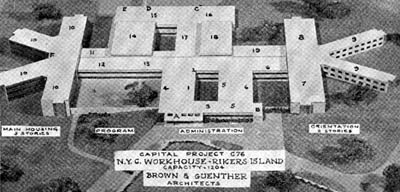| The 1950 Beginning: A Board of Estimate resolution
The history of the official names for Riker's C-76 -- with capacity for 2,250 inmates, one of the largest among the island's 10 jails -- traces back at least a half-century. As a result of a resolution adopted by the NYC Board of Estimate, a firm of architects was retained on Jan. 26, 1950, to draw up plans for what Correction Commissioner Anna M. Kross five years later described as "plans for the modernization of Rikers Island and to create two independent self-contained institutions -- a Penitentiary and Workhouse -- to proprerly accommodate a diverse inmate population. . .

|
|
The title above this architectural sketch of "Capital Project C76 NYC Workhouse - Rikers Island" in the 1959 annual report [page 28] read: The New Proposed Institution Scheduled to Supplant the Present Condemned Hart Island Institution. The text with the sketch listed facility features whose planned locations were identified by roof numbers.
|
"In 1950, the sum of $100,000 was allocated in the Capital Outlay Budget for the modernization project." [page 45, official Digest of NYC DOC 1954 annual report]
Kross' predecessor, Commissioner Albert Williams began his 1951 annual report to Mayor Vincent R. Impellitteri by citing, in its first paragraph, progress toward "the realization of the program envisioned for the two institutions [Penitentiary and Workhouse] situated on Rikers Island. The firm of Alfred Hopkins and Associates, who were engaged for . . . planning required for the modification of facilities, . . .completed an extensive and all-embracing survey involving every aspect of the problems presented by the two institutions. . . ."
But what started out being planned in 1950 as a new improved Rikers Island Workhouse encountered developments in 1954 that would eventually changed the direction its planning, construction and name would take. Those developments included:
- The appointment as Correction Commissioner of Judge Anna M. Kross, 20-year veteran on the bench in the city's Criminal Courts and a vigorous advocate of progressive penology.
- Her immediate backing for having a Rikers Penitentiary reception center where inmates could be studied, evaluated, classified and, if warranted, referred to appropriate programs.

|
|
The title above this architectural sketch in the 1959 annual report [page 29] read: Institution to Supplant Hart Island Workhouse of the City of New York. Rikers Island, Via 1500 East 134th St., Bronx, 54, N.Y. The address referred to the ferry slip that provided access to Rikers in pre-bridge years.
|
- Jail system overcrowding that prompted the Correction Dept. to regain use of Hart Island facilities as a Branch Workhouse to relieve inmate population pressures on the Rikers Island Workhouse for which C-76 was to be the replacement.
In the 1959 annual report, C-76 was still being referred to as the replacement Workhouse. A section [pages 27 -29] on the "1960 Capital Budget project C-76" put the total estimated cost at $7,860,000, of which less than $300,000 had been appropriated by Dec. 31, 1959. A City Administrator's report was quoted as finding "A new Workhouse should be constructed at Rikers Island." While the architectural plans were estimated as 75 percent complete, no construction funds had yet been allocated.
In the 1961 annual report, a map of construction projects and existing facilities on Rikers showed C-76 labeled N.Y.C. Workhouse yet the text list of projects carried a C-76 entry straddling both missions: C-76 Institution to replace the Hart Island Workhouse with a New York City Reception and Classification Center.
But by January, 1963, when Commissioner Kross submitted her 1962 annual report to Mayor Robert F. Wagner, it included a section [pages 25-26] on the project with a new title: C-76 Reception and Classification Center. The planned facility was still being described as "being built to supplant the obsolete and outmoded Workhouse on Hart Island." The cost was raised the $10 million and its completion set for the summer of 1963. The report did mention housing for the kind of inmate population usuallly identified with a Workhouse:
Accommodations are provided for alcoholics, drug addicts, non-support cases and traffic violators, principally in dormitory housing.

|
|
The caption for this photo from Page 25 of the 1962 annual report read: The New York City Correctional Reception and Classification Center at Rikers Island was substantially completed in 1962 with the interior to be completed in 1963.
|
However, the report added: The new facility will also serve as a reception and classification center for all males sentenced to this department by the courts.
The sentenced group undergoing classification will be housed in a quarantine section for approximately two weeks where they will receive diagnosis and screening by the behavioral disciplines for the purpose of setting up an institutional program of individualized and group treatment.
Commissioner Kross' final annual report, submitted Dec. 31, 1965, listed on the inside of its front cover page, a list of DOC institutions and their respective wardens.

|
|
Warden Francis R. Buono
|
Heading the column for "Sentence" institutions was the New York City Correctional Reception & Classification Center, Rikers Island. Francis R. Buono, Warden. On Page 365 of that report, entited Progress Through Crisis: 1954 - 1965, she explained the change:Although the present Reception & Classification Center building was originally planned to replace the old traditional workhouse, our growing understanding of the mechanics of true correction and of the need for something far beyond the haphazard work assignments of time-worn practices led us to our present short-term pioneering effort. A new phase of our Rehabilitation Program is being undertaken there.
|






